

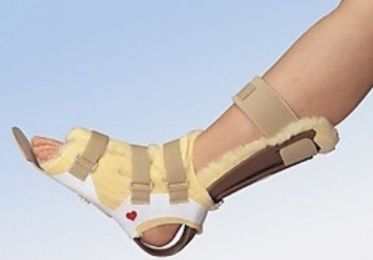
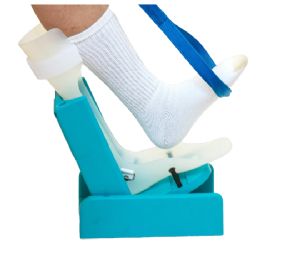


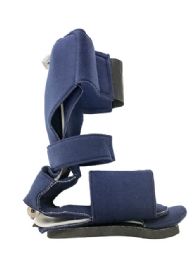





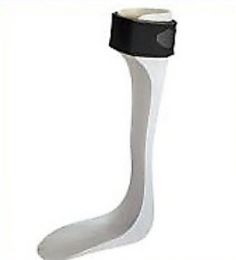
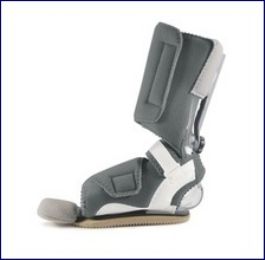
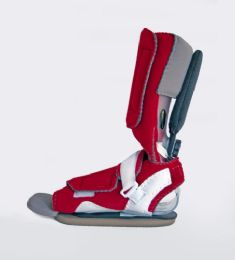
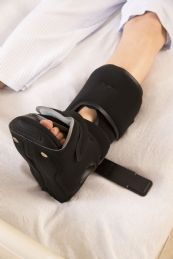
What are Multi Podus Boots Used For?
While multi podus boots and AFOs are employed for different applications such as protection for healing pressure ulcers, deep wounds and other heel injuries, along with contracture management for conditions like plantar fasciitis, they are probably most commonly used for foot drop problems.
Defined as the inability to lift or dorsiflex the foot or toes, foot drop is not a disease in itself but rather a symptom of a larger problem. Also referred to as drop-foot, this condition can be permanent or temporary, occurring in either just one foot, or both. Individuals with foot drop are not able to lift their toes and/or their foot from the ankle, causing them to bend their knees while walking so that they don’t drag their feet along the ground. People with foot drop may also tiptoe walk on the opposite leg if they can’t lift their toes on the other foot, with excessive raising of the thigh. Another characteristic steppage gait indicative of foot drop displays a wide outward leg swing, especially when turning opposite corners of the affected foot’s direction.
Foot drop has many different root causes, including disease, injury or toxic buildup. Amyotrophic lateral sclerosis (ALS), multiple sclerosis (MS), cerebral palsy (CP), muscular dystrophy (MD), Charcot-Marie Tooth disease, Friedreich’s ataxia and stroke are all possible culprits in creating foot drop issues. Stroke, hereditary spastic paraplegia, common fibular nerve damage, sciatica, spinal cord trauma, abnormal anatomy and paralysis of the anterior muscles in the lower legs can also cause this condition.
How do Multi Podus Boots and AFOs Help to Treat Foot Drop?
As one of the most commonly used orthoses, multi podus boots and AFOs comprise about 26% of the total orthoses used in the United States. Most frequently formed into an “L” shape, multi podus AFOs feature a lower portion that slides under the foot with an upright portion that fits behind the calf of the leg. Unbroken “L” designs provide the hardest rigidity, while other configurations may highlight alternative methods of control with a jointed ankle piece.
Multi podus AFOs are available in a variety of designs for fulfilling unique requirements. One such design is the use of a cuff placed around the ankle that includes a spring under the shoelaces and a topside hook, lifting the shoe as the user walks. A similar format includes spring-loaded braces that fit inside the user’s shoes.
What Multi Podus AFO is Right for Me?
While there are a multitude of multi podus boots and AFOs to choose from, here are some of the most commonly used configurations that physicians recommend for foot drop, to help users with this condition to attain a more comfortable and normal gait. It is highly recommended to consult with your doctor before choosing what type of multi podus boots are right for you. Our selection of multi podus orthoses include specially designed formations to control motion, provide proper positioning for the ankle, correct deformities and compensate for weaknesses.
Plantarflexion Stop Multi Podus AFO:
This AFO features a hinge that offers the user normal dorsiflexion, stopping plantarflexion through its ability to stop the downward point of the foot. While this style may be a bit bulkier than other AFOs, it may be well suited for users with more severe foot drop problems.
Solid Ankle Multi Podus AFO:
This is a good style for users who suffer from unstable knees along with foot drop, and who have lost most or all of their dorsiflexion strength. The configuration is sizable, but the solid ankle multi podus offers superior control, stopping both dorsiflexion and plantarflexion.
Short Leg Multi Podus AFO with Fixed Hinge:
Easy to fit into shoes and offering superior foot control, this relatively lightweight AFO keeps the foot at a 90-degree angle to the leg. Aside from aiding in foot drop, the short leg AFO can also treat flat feet and help control unwanted inward foot rotation, a common side effect in users with Charcot-Marie Tooth disease and recovery from stroke. This AFO design is most commonly used for users under 6 feet tall, and it does stop plantarflexion and dorsiflexion movements.
Dorsiflexion Assist Short Leg Multi Podus AFO:
As another configuration that works best for users less than 6 feet tall and under 225 pounds, this unique AFO incorporates a spring-like hinge to raise the foot, dorsiflexing the ankle which results in a more normal gait pattern. This AFO is one of the most commonly recommended for users with mild to moderate foot drop issues, while it is also often employed for unstable or flat feet problems. This type may also be referred to as the Dorsiflexion Assist Functional AFO.
Full Leg Posterior Leaf Spring Multi Podus AFO:
A more traditional AFO, the full leg posterior leaf spring style has been popular for many years. While it may not be as lightweight as its more modern counterparts, many healthcare professionals still prefer this choice for patients who are affected by greater knee instability combined with foot drop problems.
Energy Return Multi Podus AFO:
Very lightweight in design, this AFO is often constructed using carbon graphite materials. The natural flex designed into these specialized materials provides comfortable and supportive dorsiflexion movements, resulting in a more energized gait for the user.
Hulet Smith, OT
Rehabmart Co-Founder & CEO
ck